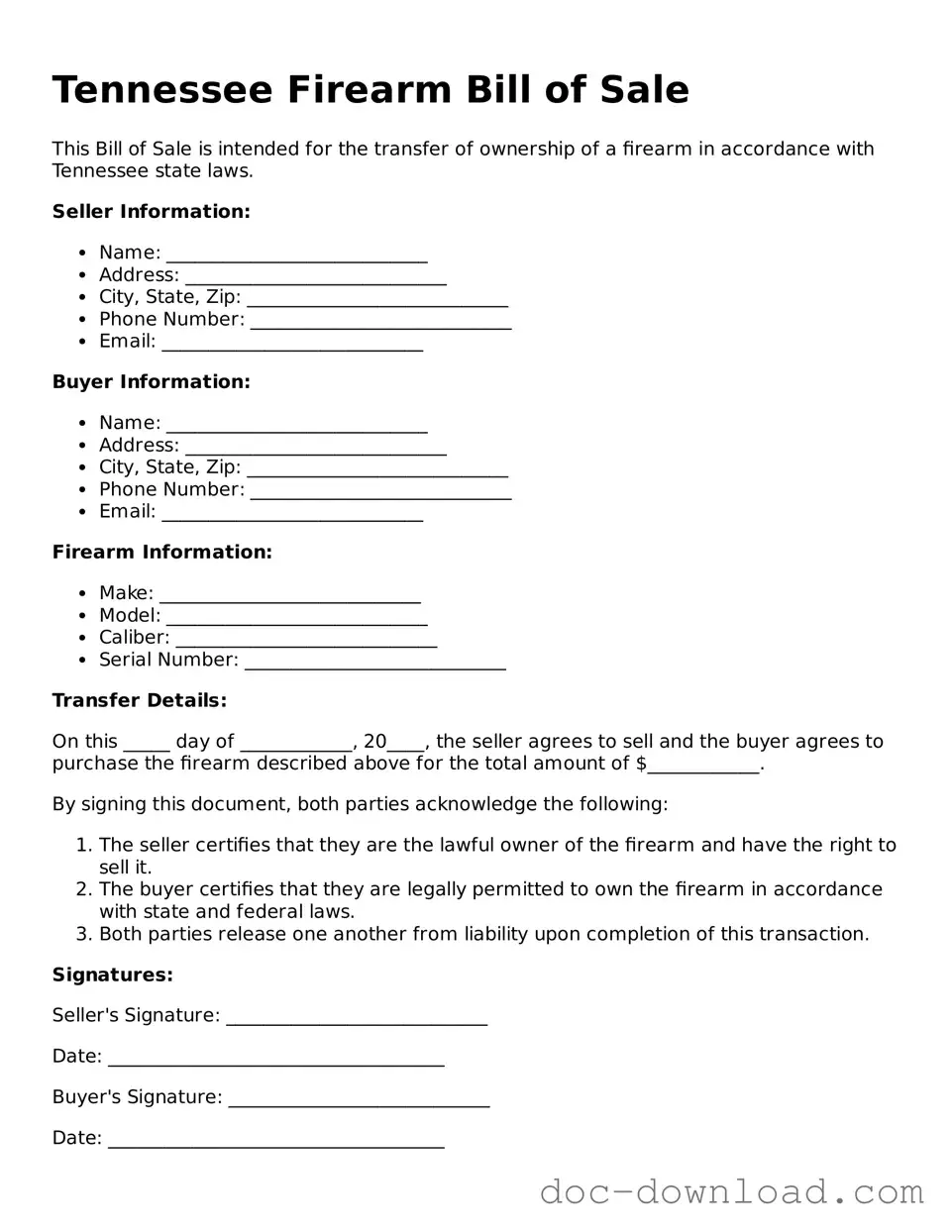The Tennessee Firearm Bill of Sale form shares similarities with the general Bill of Sale document used for various types of property transactions. A Bill of Sale serves as a receipt for the transfer of ownership from one party to another. This document typically includes details about the buyer and seller, a description of the item being sold, and the sale price. Just like the Firearm Bill of Sale, it provides a legal record of the transaction, ensuring that both parties have proof of ownership transfer, which can be crucial for future reference or disputes.
Another document akin to the Tennessee Firearm Bill of Sale is the Vehicle Bill of Sale. This form is used when a motor vehicle is sold and includes similar elements such as the names of the buyer and seller, vehicle identification details, and the sale price. Both documents serve the purpose of documenting ownership changes and can be used to verify the legitimacy of the transaction in case of future legal matters. In both instances, the Bill of Sale acts as a protective measure for the parties involved.
The Lease Agreement is another document that bears resemblance to the Tennessee Firearm Bill of Sale. While a Lease Agreement pertains to the rental of property rather than a sale, it still requires clear identification of the parties involved, the terms of the agreement, and a description of the property. Both documents establish the rights and responsibilities of each party, ensuring that there is a mutual understanding of the terms. In this way, both documents protect the interests of the involved parties.
The Purchase Agreement, often used in real estate transactions, is similar to the Firearm Bill of Sale in its function of documenting a transfer of ownership. This agreement outlines the terms of the sale, including price, property details, and contingencies. Like the Firearm Bill of Sale, it serves as a formal record that can be referenced in case of disputes, providing legal protection to both buyers and sellers.
A Sales Receipt is also comparable to the Tennessee Firearm Bill of Sale. While typically simpler, a Sales Receipt provides proof of a transaction and includes essential details such as the date of sale, item description, and purchase amount. Both documents serve as evidence of the transfer of ownership, although the Firearm Bill of Sale includes specific information pertinent to firearm transactions, such as serial numbers and compliance with state laws.
To safeguard your interests and ensure your wishes are honored, consider utilizing a crucial form known as the Durable Power of Attorney. This legal document empowers a designated individual to make decisions on your behalf in times of incapacity. For more information about this vital process, you can explore the guide that details the Durable Power of Attorney form requirements by visiting this essential guide for Durable Power of Attorney.
The Affidavit of Ownership is another document that shares commonalities with the Firearm Bill of Sale. This affidavit is often used to assert ownership of property when the original documentation is unavailable. Similar to the Firearm Bill of Sale, it requires the owner to provide specific details about the item, thus serving as a legal affirmation of ownership. Both documents can play a crucial role in establishing rightful ownership in various contexts.
The Donation Receipt can also be likened to the Tennessee Firearm Bill of Sale, particularly when firearms are transferred as gifts. This receipt documents the transfer of ownership without a monetary exchange and includes information about the donor and recipient, as well as a description of the firearm. Both documents serve to formalize the transfer, ensuring that the new owner has proof of acquisition, which can be important for legal and regulatory purposes.
Lastly, the Transfer of Title document, often used in the context of vehicles or property, bears similarities to the Firearm Bill of Sale. This document formally records the change of ownership and is typically required for legal recognition of the new owner. Both documents ensure that the transaction is documented and that the new owner can assert their rights over the item, thereby providing a layer of legal protection and clarity in ownership matters.
